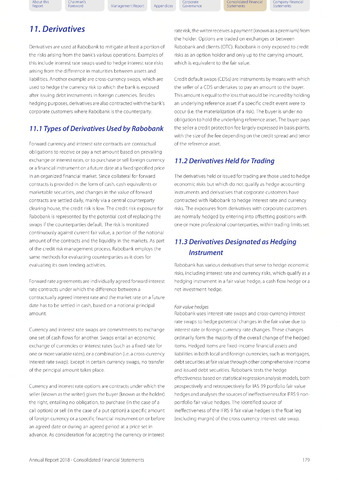11. Derivatives
7 7.7 Types of Derivatives Used by Rabobank
7 7.2 Derivatives Held for Trading
7 7.3 Derivatives Designated as Hedging
Instrument
About this
Report
Chairman's
Foreword
Corporate
Management Report Appendices Governance
Consolidated Financial Company Financial
Statements Statements
Derivatives are used at Rabobankto mitigate at least a portion of
the risks arising from the bank's various operations. Examples of
this include interest rate swaps used to hedge interest rate risks
arising from the difference in maturities between assets and
liabilities. Another example are cross-currency swaps, which are
used to hedge the currency risk to which the bank is exposed
after issuing debt instruments in foreign currencies. Besides
hedging purposes, derivatives are also contracted with the bank's
corporate customers where Rabobank is the counterparty.
Forward currency and interest rate contracts are contractual
obligations to receive or pay a net amount based on prevailing
exchange or interest rates, orto purchase or sell foreign currency
or a financial instrument on a future date at a fixed specified price
in an organized financial market. Since collateral for forward
contracts is provided in the form of cash, cash equivalents or
marketable securities, and changes in the value of forward
contracts are settled daily, mainly via a central counterparty
clearing house, the credit risk is low. The credit risk exposure for
Rabobank is represented by the potential cost of replacing the
swaps if the counterparties default. The risk is monitored
continuously against current fair value, a portion of the notional
amount of the contracts and the liquidity in the markets. As part
of the credit risk management process, Rabobank employs the
same methods for evaluating counterparties as it does for
evaluating its own lending activities.
Forward rate agreements are individually agreed forward interest
rate contracts under which the difference between a
contractually agreed interest rate and the market rate on a future
date has to be settled in cash, based on a notional principal
amount.
Currency and interest rate swaps are commitments to exchange
one set of cash flows for another. Swaps entail an economic
exchange of currencies or interest rates (such as a fixed rate for
one or more variable rates), or a combination (i.e. a cross-currency
interest rate swap). Except in certain currency swaps, no transfer
of the principal amount takes place.
Currency and interest rate options are contracts under which the
seller (known as the writer) gives the buyer (known as the holder)
the right, entailing no obligation, to purchase (in the case of a
call option) or sell (in the case of a put option) a specific amount
of foreign currency or a specific financial instrument on or before
an agreed date or during an agreed period at a price set in
advance. As consideration for accepting the currency or interest
rate risk, the writer receives a payment (known as a premiu m) from
the holder. Options are traded on exchanges or between
Rabobank and clients (OTC). Rabobank is only exposed to credit
risks as an option holder and only up to the carrying amount,
which is equivalent to the fair value.
Credit default swaps (CDSs) are instruments by means with which
the seller of a CDS undertakes to pay an amount to the buyer.
This amount is equal to the loss that would be incurred by holding
an underlying reference asset if a specific credit event were to
occur (i.e. the materialization of a risk). The buyer is under no
obligation to hold the underlying reference asset. The buyer pays
the seller a credit protection fee largely expressed in basis points,
with the size of the fee depending on the credit spread and tenor
of the reference asset.
The derivatives held or issued for trading are those used to hedge
economic risks but which do not qualify as hedge accounting
instruments and derivatives that corporate customers have
contracted with Rabobank to hedge interest rate and currency
risks. The exposures from derivatives with corporate customers
are normally hedged by entering into offsetting positions with
one or more professional counterparties, within trading limits set.
Rabobank has various derivatives that serve to hedge economic
risks, including interest rate and currency risks, which qualify as a
hedging instrument in a fair value hedge, a cash flow hedge or a
net investment hedge.
Fair value hedges
Rabobank uses interest rate swaps and cross-currency interest
rate swaps to hedge potential changes in the fair value due to
interest rate or foreign currency rate changes. These changes
ordinarily form the majority of the overall change of the hedged
items. Hedged items are fixed-income financial assets and
liabilities in both local and foreign currencies, such as mortgages,
debt securities at fair value through other comprehensive income
and issued debt securities. Rabobank tests the hedge
effectiveness based on statistical regression analysis models, both
prospectively and retrospectively for IAS 39 portfolio fair value
hedges and analyses the sources of ineffectiveness for IFRS 9 non-
portfolio fair value hedges. The identified source of
ineffectiveness of the IFRS 9 fair value hedges is the float leg
(excluding margin) of the cross currency interest rate swap.
Annual Report 2018 - Consolidated Financial Statements
179

